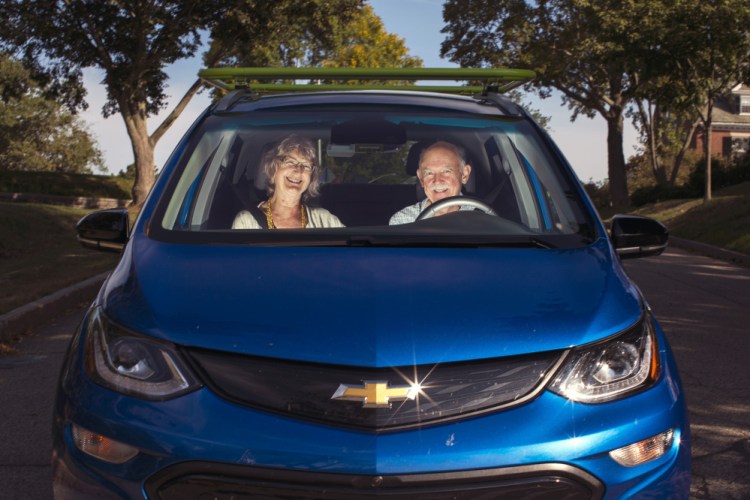First of all, the Chevy Bolt is not technically Allen Armstrong’s car. It’s his wife Elissa’s, but she lets him drive it, all over their hometown of Portland and beyond. She also gave the go-ahead to talk to Source about just what makes it so great, how much it cost them and how a guy who used to treasure his gas guzzlers got interested in electric cars in the first place.
IS THIS YOUR FIRST? First fully electric car, yes, but Allen Armstrong has a hybrid already, an early generation (2006) Honda Insight. The Armstrongs do have two other electric vehicles however.
COME AGAIN? “Two recumbent trikes.” Those bike-like things you lie down in? Yes. “And in this particular case, they now have motors on them.” The older of the two he converted to electric two years ago for his wife. “And she found it so helpful in getting around town, particularly on the hills.” We’re talking Munjoy? “State Street is the classic. That is the one I find most challenging in Portland.” He actually built one of the trikes himself (he’s a retired engineer who worked in semiconductors in Massachusetts for much of his career). Were these the gateways to an electric car? “I think they were! I just found out how pleasant electric is. That smooth power…you just drive it with one foot and it does exactly what you want.”
HOLD ON THERE: We pointed out that we drive our gas-powered Outback with just one foot and it does exactly what we want it to, and Armstrong laughed and conceded that he’d always driven a stick, so maybe that was the difference. Nonetheless, he likes the car and the way it drives. “I think if I let you drive it, you’d get it.”
LONG DAY’S JOURNEY INTO BOSTON: The car’s range on a full charge is between 240 and 270 miles. The couple recently tested its limits on a trip to Boston. Were they nervous about making it there and back? “Yes indeed, we were. So what we actually did was we plugged it into a wall outlet in Lexington where we were staying, just to make sure.”
PLUG IT IN: Wait, a wall outlet? Yes, Armstrong explains, he can charge the car on a 110-volt outlet, it just doesn’t take the charge very fast (4 miles per hour). At home he’s got a 220-volt outlet for the car. “That will charge at 25 mph.” Thus his bedtime routine involves plugging in the car. “It works best if you let it go overnight, so having one in one’s home is pretty convenient.” They have yet to try out a commercial charger, even though they’ve had the Bolt since the beginning of June.
POWER STATIONS: Why not? “It is just kind of expensive.” A charge down at the station near the Portland Hannaford on Forest Avenue would cost him about $11, which would get him about 50 miles, he said, and that seems like a lot for now. Kind of like paying marked-up prices for convenience at the corner store – why do it if you don’t have to? But the Armstrongs are planning a cross-country jaunt soon. “We know we are going to have to plot where the stations are.”
PRICE TAG: What did the blue Bolt cost them? “After the tax credit, it will cost us about $35,000.” The tax credit is $7,500, and if they don’t have that kind of tax liability this year, they can roll it over, as they once did with their solar panels. They installed the panels about five years ago, and because the historic district in the West End limited what they could do to the roof, the panels produce just 1.8 kilowatts of power. Recently they joined the Freeport community solar farm to pick up another 6 kilowatts.
HOW LONG HAS THIS BEEN GOING ON? They’re serious about sustainability, but Armstrong said that’s a relatively new thing for him. “It had sort of a religious origin,” he said. “I go to a Unitarian Universalist church, and I went in 2004 to the national convention. They were proposing a study issue for the year on global warming and species extinction. I had no notion what it was or any interest in it. But once my attention was drawn to it, I decided to teach an adult education class just to learn about it. I am an engineer, and I was intrigued by the problem.”
AN AWAKENING: He says it was a shock to realize he should alter a lifelong habit that started in 1957 when he acquired a 1947 Renault (“totally worn out. Had taken four coal miners to work for years in Illinois before I got it”). “I had loved old gas-powered things. I had a lot of motorcycles. Chainsaws. Every kind of gas-powered thing and particularly old cars. All of a sudden I realized I can’t have fun blasting around in these things knowing that I am polluting the atmosphere.” Or more like, contributing to climate change, right? Yes, Armstrong says.
BEST OF THE BOLT: He’s pretty happy with this car, although it has one problem he says he’s discussed with other Bolt owners. He had a chance to meet some other Mainers with Chevy Bolts at a recent test-drive event organized by the Natural Resources Council of Maine. “Everybody complains about the shift lever. You have to push in this little button. The way it works is a little counterintuitive. But in other respects, they got it so right. I have tremendous respect for the engineers who put this together.”
Mary Pols can be contacted at 791-6456 or at:
Twitter: MaryPols
Send questions/comments to the editors.



